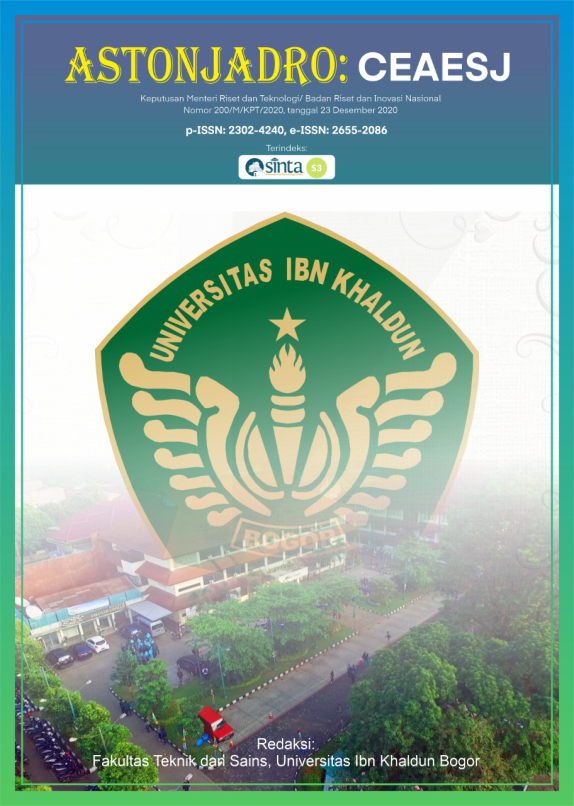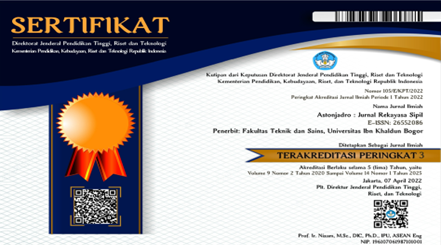THEORY OF PLANNED BEHAVIOR APPLICATION ON MOTORCYCLE RIDER SAFETY BEHAVIOR
DOI:
https://doi.org/10.32832/astonjadro.v11i1.5990Keywords:
traffic accident, safety behavior, motorcyclist, theory of planned behavior, structural equation modeling.Abstract
In Indonesia, the basis for implementing road safety consists of five pillars which are compiled in the General National Road Safety Plan (RUNK). One of the pillars proclaimed is the behavior of safe road users. This aims as an effort to reduce traffic accidents because road users are the biggest factor in road accidents related to user behavior. The cases of road traffic accidents in Indonesia are dominated by motorcyclists, especially Jakarta, which is one of the cities with a fairly high rate of motorcycle accidents. Because the behavior of road users is closely related to traffic accidents, and also motorcyclists are the users who are involved in the highest traffic accidents, this study explains the factors that determine the safety behavior of motorcyclists in Jakarta. The application of the Theory of Planned Behavior (TPB) is used as a basis for finding the factors that may determine the behavior of the motorcyclist. Furthermore, the research approach used in this study is quantitative with primary data in the form of a closed questionnaire instrument from 230 respondents who ride motorcycles in Jakarta. The data analysis technique used is the Structural Equation Modeling (SEM) approach using the AMOS 22.00 program as a tool in determining the determinants of driver safety behavior. The results of the analysis show that the most dominant direct predictor in determining the safety behavior of motorcyclists in Jakarta is the intention to behave safely. While the indirect factor that determines is the attitude of the driver. The results of the analysis also show that the age of the driver has a significant influence on safety behavior.
References
Agustina, & Lupita. 2019. Faktor-Faktor Yang Berhubungan dengan Tingkat Kelelahan Kerja pada Pengemudi Ojek Online di Wilayah Jakarta Timur Tahun 2019. Jurnal Persada Husada Indonesia, 6(23), 25–36. (Indonesian).
Ajzen, I. 1991. The theory of planned behavior. Organizational Behavior and Human Decision Processes, 50(2), 179–211. https://doi.org/10.1016/0749-5978(91)90020-T
Brijs, K., Brijs, T., Sann, S., Trinh, T. A., Wets, G., & Ruiter, R. A. C. 2014. Psychological determinants of motorcycle helmet use among young adults in Cambodia. Transportation Research Part F: Traffic Psychology and Behaviour, 26(PA), 273–290. https://doi.org/10.1016/j.trf.2014.08.002
Budiaji, W. 2013. Skala Pengukuran dan Jumlah Respon Skala Likert (The Measurement Scale and The Number of Responses in Likert Scale). Ilmu Pertanian Dan Perikanan, 2(2), 127–133. (Indonesian).
Castanier, C., Deroche, T., & Woodman, T. 2013. Theory of planned behaviour and road violations: The moderating influence of perceived behavioural control. Transportation Research Part F: Traffic Psychology and Behaviour, 18(2013), 148–158. https://doi.org/10.1016/j.trf.2012.12.014
Cheng, A. S. K., Liu, K. P. Y., & Tulliani, N. 2015. Relationship between driving-violation behaviours and risk perception in motorcycle accidents. Hong Kong Journal of Occupational Therapy, 25, 32–38. https://doi.org/10.1016/j.hkjot.2015.06.001
Dirjen Bina Marga, 2012. Panduan Teknis 1 Rekayasa Keselamatan Jalan. Jakarta: Kementerian Pekerjaan Umum Republik Indonesia. (Indonesian).
Enggarsasi, U., & Sa'diyah, N. K. 2017. Kajian terhadap Faktor-Faktor Penyebab Kecelakaan Lalu Lintas dalam Upaya Perbaikan Pencegahan Kecelakaan Lalu Lintas. Perspektif, 22(3), 238–247. https://doi.org/10.30742/perspektif.v22i3.632 (Indonesian).
French, D. J., West, R. J., Elander, J., & Wilding, J. M. 1993. Decision-making style, driving style, and self-reported involvement in road traffic accidents. Ergonomics, 36(6), 627–644. https://doi.org/10.1080/00140139308967925
Haryanto, H. 2016. Keselamatan Dalam Berkendara: Kajian Terkait Dengan Usia Dan Jenis Kelamin Pada Pengendara. Inquiry, 7(2), 231153. (Indonesian).
Haryono, S., 2016. Metode SEM: AMOS, LISREL, PLS. Jakarta: PT. Intermedia Personalia Utama. (Indonesian).
Lajunen, T., & Räsänen, M. 2004. Can social psychological models be used to promote bicycle helmet use among teenagers? A comparison of the Health Belief Model, Theory of Planned Behavior and the Locus of Control. Journal of Safety Research, 35(1), 115–123. https://doi.org/10.1016/j.jsr.2003.09.020
Ledesma, R. D., Tosi, J. D., Díaz-Lázaro, C. M., & Poó, F. M. (2018). Predicting road safety behavior with implicit attitudes and the Theory of Planned Behavior. Journal of Safety Research, 66, 187–194. https://doi.org/10.1016/j.jsr.2018.07.006
Li, P., Shi, J., Liu, X., & Wang, H. 2016. The Theory of Planned Behavior and Competitive Driving in China. Procedia Engineering, 137, 362–371. https://doi.org/10.1016/j.proeng.2016.01.270
Marsaid, Hidayat, M., & Ahsan. 2013. Faktor yang Berhubungan dengan Kejadian Kecelakaan Lalu Lintas pada Pengendara Sepeda Motor di Wilayah Polres Kabupaten Malang. Jurnal Ilmu Keperawatan, 1(2), 98–112. https://doi.org/http://dx.doi.org/10.11606/issn.2176-7262.v49i5p475-482 (Indonesian).
Mostafavi, F., Nasirian, M., Zeinali, M., Ardalan, G., Mohebpou, F., Daniali, S. S., Pirzadeh, A., & Kelishadi, R. 2021. Evaluating Community"‘Based Programs in Promoting Traffic Behaviors and Safe Road Crossing Behaviors in Youth: An Application on Theory of Planned Behavior. International Journal of Preventive Medicine, 12. https://doi.org/10.4103/ijpvm.IJPVM_241_20
Mukhid, A. 2008. STRATEGI SELF-REGULATED LEARNING (Perspektif Teoritik). Tadris, 3(2), 222–239.
Nguyen-Phuoc, D. Q., Oviedo-Trespalacios, O., Nguyen, T., & Su, D. N. 2020. The effects of unhealthy lifestyle behaviours on risky riding behaviours – A study on app-based motorcycle taxi riders in Vietnam. Journal of Transport and Health, 16(January), 100666. https://doi.org/10.1016/j.jth.2019.100666
Retnawati, H. 2015. The Comparison of The Accuracy of Likert Scale. Jurnal Kependidikan: Penelitian Inovasi Pembelajaran, 45(2), 156–167. (Indonesian).
Sabbour, S. M., & Ibrahim, J. M. 2010. Driving behaviour, driver style and road traffic accidents among young medical group. Injury Prevention, 16(Supplement 1), A33–A33. https://doi.org/10.1136/ip.2010.029215.120
Åžimşekoǧlu, í–., & Lajunen, T. 2008. Social psychology of seat belt use: A comparison of theory of planned behavior and health belief model. Transportation Research Part F: Traffic Psychology and Behaviour, 11(3), 181–191. https://doi.org/10.1016/j.trf.2007.10.001
Stanojević, D., Stanojević, P., Jovanović, D., & Lipovac, K. 2020. Impact of riders' lifestyle on their risky behavior and road traffic accident risk. Journal of Transportation Safety and Security, 12(3), 400–418. https://doi.org/10.1080/19439962.2018.1490367
Sujanto, S., & Mulyono, A. T. 2010. Inspeksi Keselamatan Jalan Di Jalan Lingkar Selatan Yogyakarta. Jurnal Transportasi, 10(1), 13–22.(Indonesian).
Suprobo, Y. 2016. ANALISIS PERUBAHAN PERILAKU BERKENDARA PADA PENGEMUDI ANGKUTAN UMUM PENUMPANG. Jurnal Penelitian Transportasi Darat, 18(2), 117–132. https://doi.org/10.1017/CBO9781107415324.004 (Indonesian).
Wang, X., Yuen, K. F., Shi, W., & Ma, F. 2020. The determinants of passengers' safety behaviour on public transport. Journal of Transport and Health, 18(February), 100905. https://doi.org/10.1016/j.jth.2020.100905
Downloads
Published
How to Cite
Issue
Section
License
Copyright (c) 2021 ASTONJADRO: CEAESJ

This work is licensed under a Creative Commons Attribution-ShareAlike 4.0 International License.
Paper submitted to ASTONJADRO is the sole property of the Astonjadro Journal. Unless the author withdraws the paper because he does not want to be published in this journal. The publication rights are in the journal Astonjadro.ASTONJADRO
LICENSE
This work is licensed under a Creative Commons Attribution-ShareAlike 4.0 International License.
Based on a work at http://ejournal.uika-bogor.ac.id/index.php/ASTONJADRO













